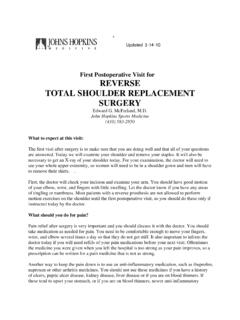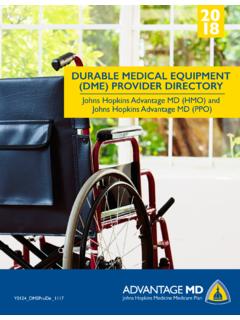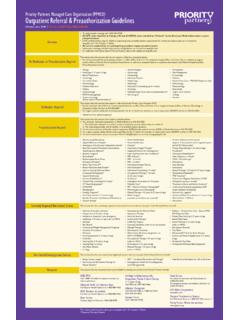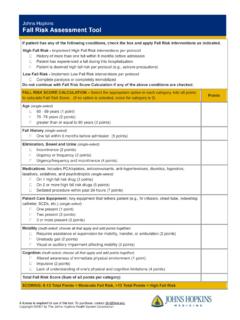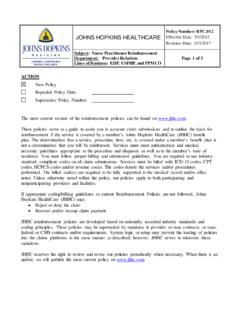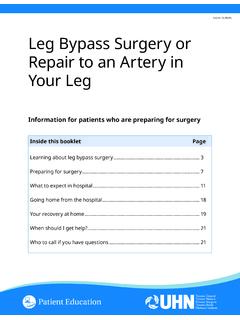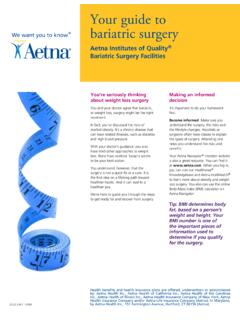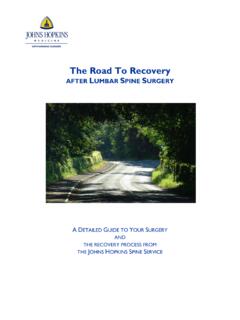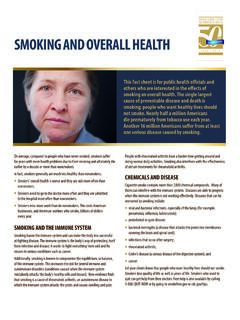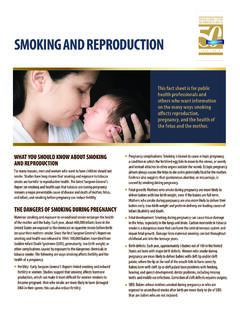Transcription of Hip Replacement Surgery Patient Education Guide
1 Johns Hopkins Hip and Knee Replacement ProgramPatient Education :Hip Replacement SurgeryWhat is Arthritis? Why Does My Hip Hurt?Your hip joint works like a ball and socket, with the upper portion of your femur (thigh bone) as the ball portion and your pelvis (hip bone) as the socket. In the hip joint, there is a layer of smooth cartilage on the upper end of the femur and in the socket of the pelvis. This cartilage serves as a cushion and allows for smooth motion of the hip. Arthritis occurs when the smooth cartilage wears away.
2 The hip can then become stiff, swollen and painful. Eventually, the cartilage can wear down to the bone and the bones can rub against one another, causing more painWhat is a Total Hip Replacement ?A total hip Replacement is when the top part of the femur and the socket part of the pelvis is replaced. This is done by placing metal alloy on the top of the femur and in the socket part of the pelvis. A smooth piece of cup-shaped plastic is inserted between this new ball and socket, which allows the ball to move smoothly.
3 Replacement of the worn cartilage with the metal and plastic implant creates a new smooth cushion and a functioning joint. Although not a normal hip, a replaced hip provides significant relief from arthritis pain. Most patients have a marked decrease in their pain with substantial improvement in function, which allows them to remain active and enjoy activities that had been limited because of Hopkins Hip andKnee Replacement ProgramThank you for choosing Johns Hopkins for your hip Replacement Surgery .
4 We use a team-based approach, and you are the most important person on this team!The Johns Hopkins Hip and Knee Replacement Program is dedicated to the care of patients undergoing hip and knee replacements. patients are admitted on the day of Surgery and are usually discharged on the first or second post-operative Hopkins Hip and Knee Replacement ProgramWhat are the Major Risks?There are known risks to having hip Replacement Surgery . Infection and blood clots are two serious complications that concern us the most.
5 To lower your risk of infection, we ask you to wash before Surgery with special cloths. We routinely use antibiotics in the operating room. To help protect you from blood clots, we use a blood thinner most commonly aspirin after with all orthopaedic Surgery , there is the risk of nerve or blood-vessel injury, as well as fracture. Additionally, the implants that are placed can become loose from the bone or the plastic can wear away over time. Your surgeon will review these risks with you in greater Type of Anesthesia will I Have?
6 Different types of anesthesia are possible for your Surgery . Your surgeon and anesthesiologist will discuss your options with you before your factors will be considered, including: Past experience with Surgery Health and physical condition Reactions or allergies you have to medicines Risks of each type of anesthesia Preferences of your surgical teamWe prefer spinal anesthesia for most of our patients undergoing total joint Replacement Surgery . Spinal anesthesia numbs you below the waist and helps you wake up quickly, resulting in less risk of nausea than general anesthesia.
7 We also will give you sedation so you are comfortable during the a CoachPlease select someone who will help you through your joint Replacement process, your coach. This person can be a family member or good friend someone you can count on to be there to help you. Your coach will go to therapy sessions while you are in the hospital and be present during your discharge Education . It is great to have someone who will support you during this Hopkins Hip and Knee Replacement ProgramJoint Replacement ClassWe offer a very informative class to help you and your coach prepare for your upcoming Surgery .
8 This class reviews important aspects of your care and what to expect during and after your hospital stay. You will meet many of the staff who will be caring for you during your stay and have a chance to have all of your questions answered. Please call 410-550-4972 to Long will I be in the Hospital?Many of our patients who have a total hip Replacement go home as early as the next day; some may stay as long as 2 days. You will have physical therapy beginning on the day of your Surgery , which will help your care team decide when you can safely be discharged.
9 Most patients are discharged with home or outpatient physical therapy. A few patients need inpatient therapy at discharge. Our care management team will work with you and your insurance provider to arrange this Hopkins Hip and Knee Replacement ProgramThe following section is a timeline to help Guide you and your coach as your Surgery date gets closer. We want to ensure that the weeks before your total joint Replacement go Weeks before SurgeryMedical and Anesthesia ClearanceYou must be seen by your primary doctor, one of our medical doctors or in our Pre-operative Evaluation Center (PEC) within 30 days of Surgery to determine if you are medically ready to have hip Replacement Surgery .
10 patients who have certain medical conditions also may need to be seen by a specialist before their Surgery . For instance, the primary care doctor may refer you to a cardi-ologist if you have a history of heart disease. The anesthesiologist also will review your medical information to clear you for anesthesia during Surgery . If you have any infection (urinary, skin, sinusitis, etc.), these will need to be treated before Surgery . You must be off antibiotics for 2 full weeks before TestsYour primary care doctor and your surgeon may order specific lab tests before Surgery .
